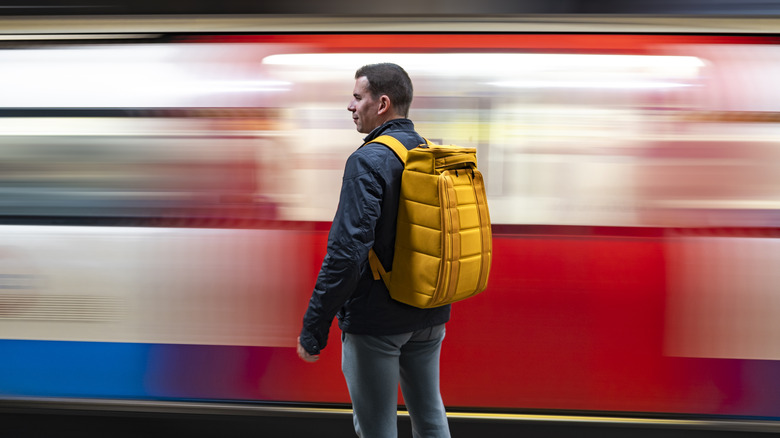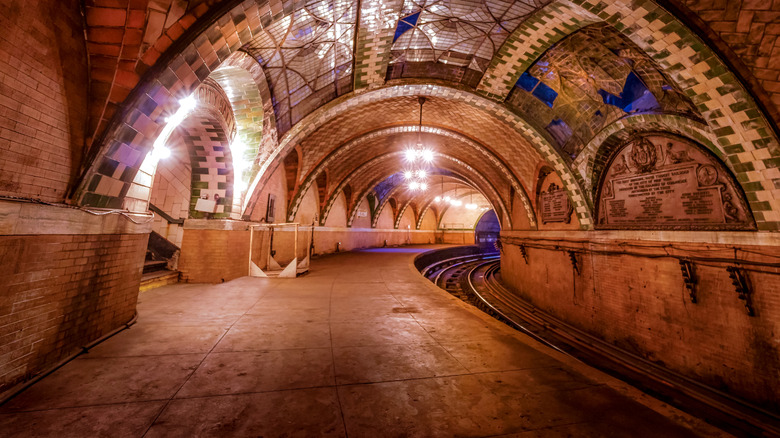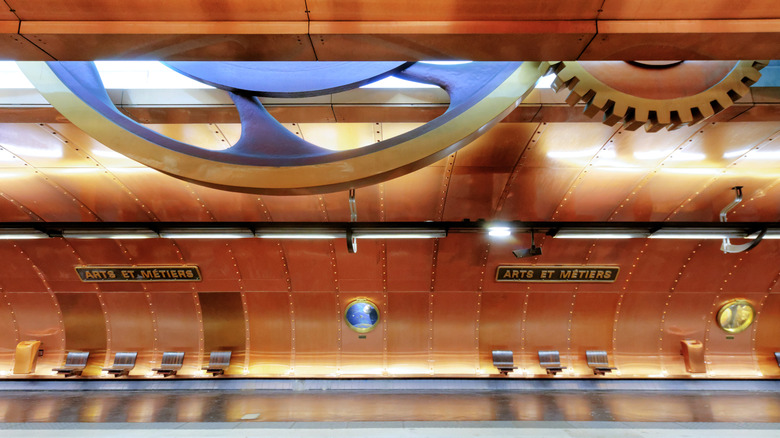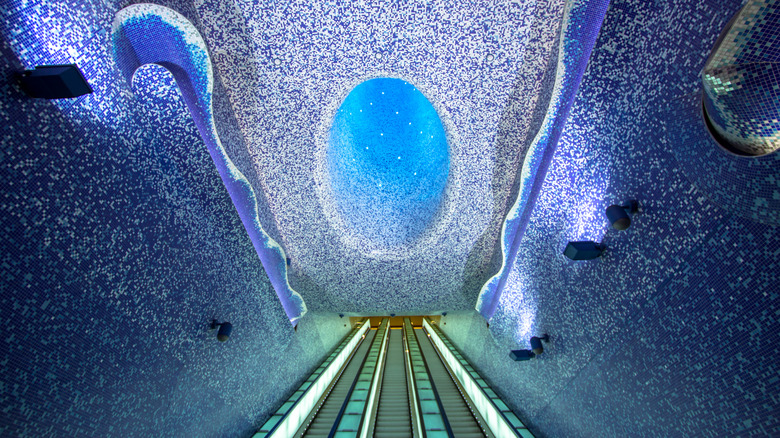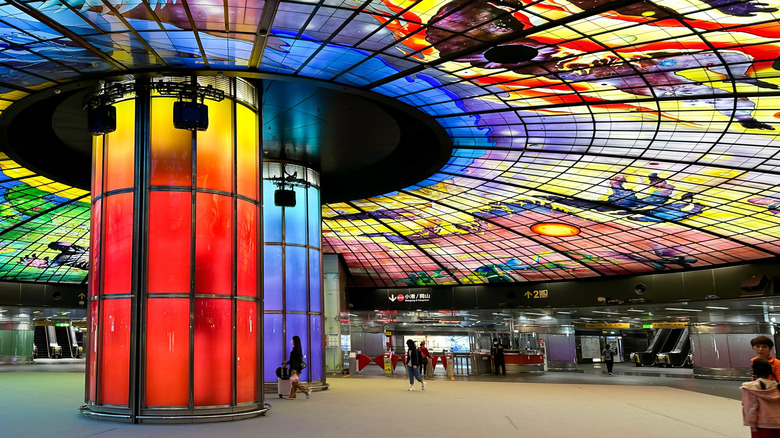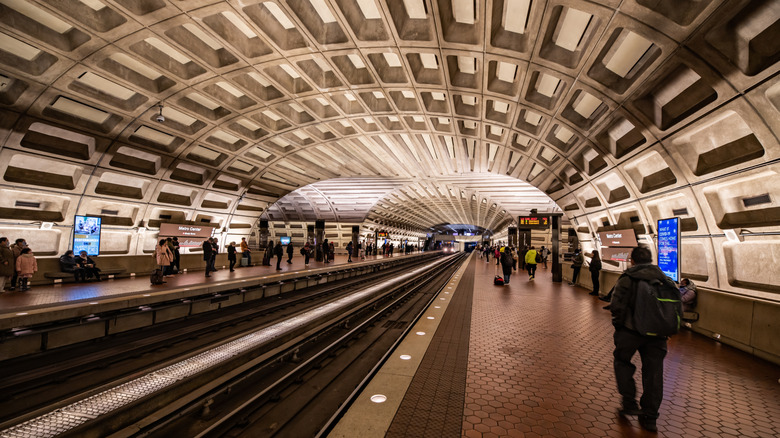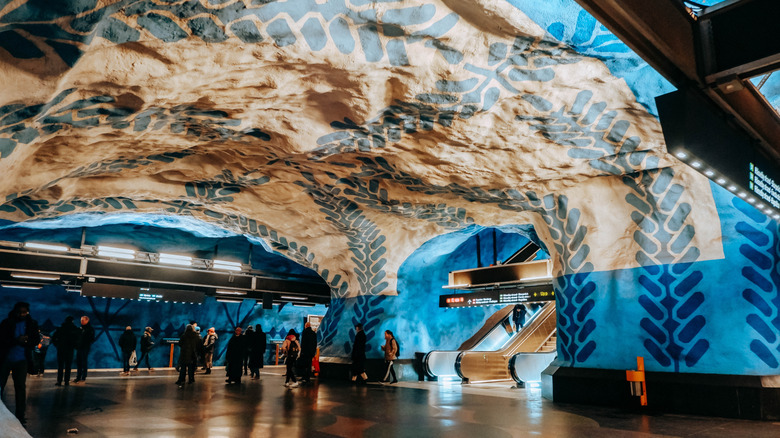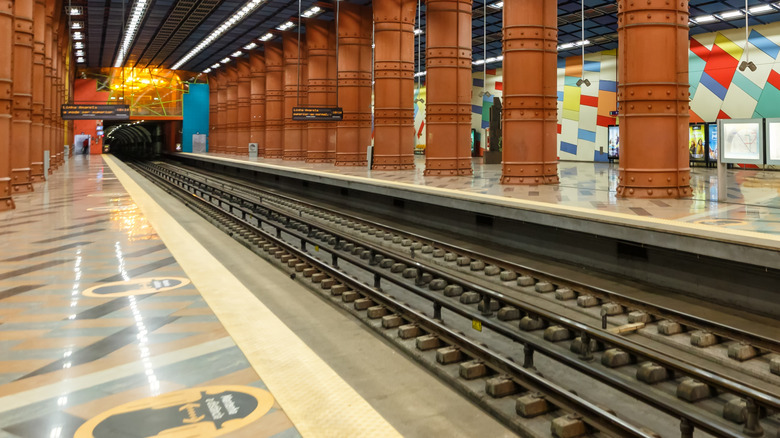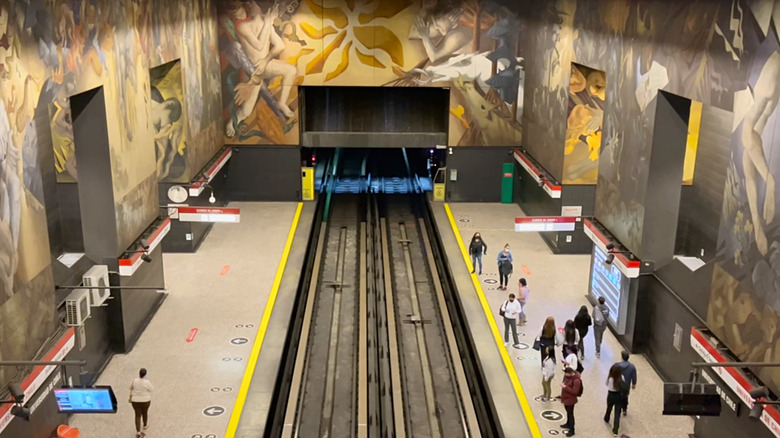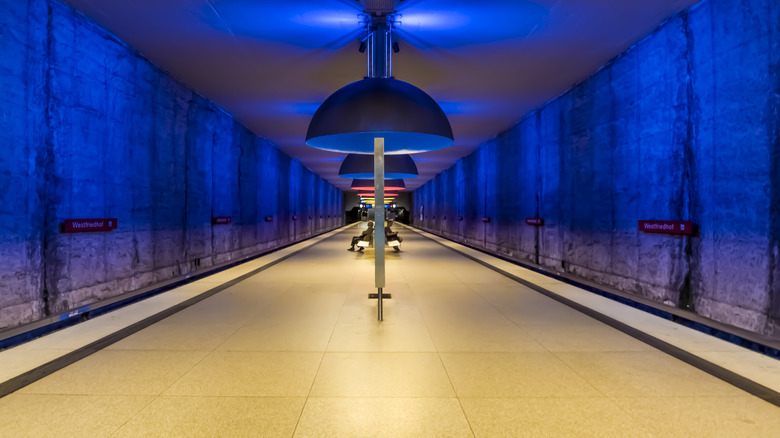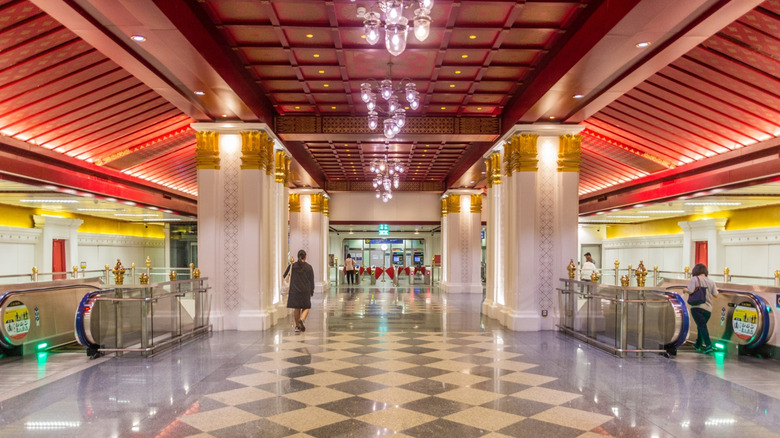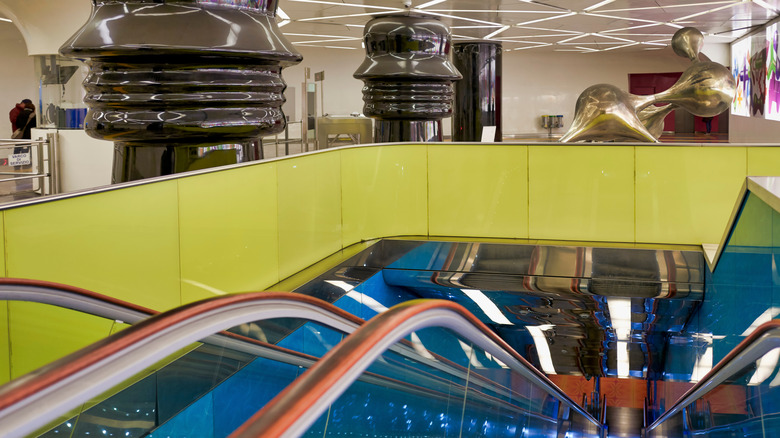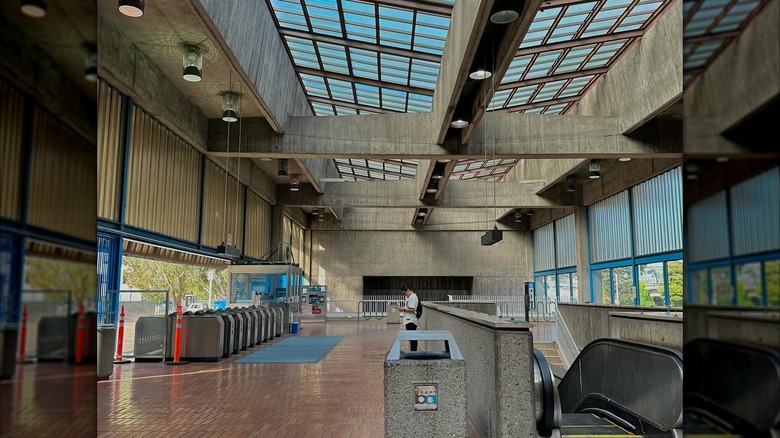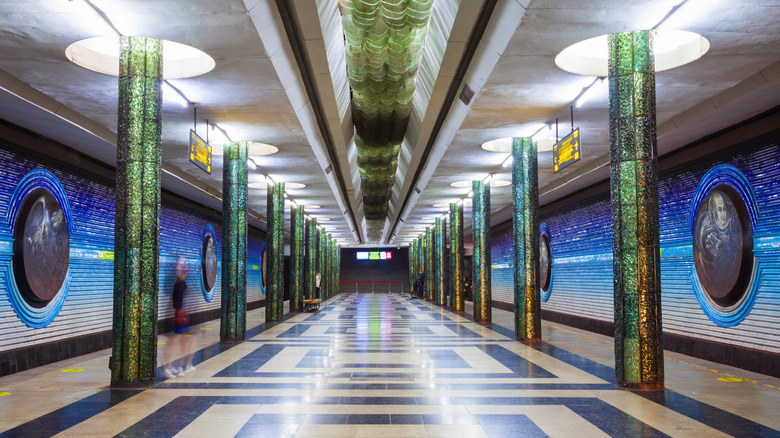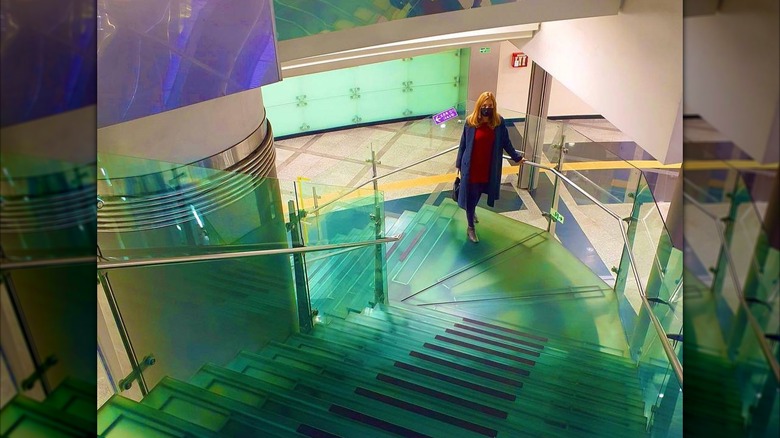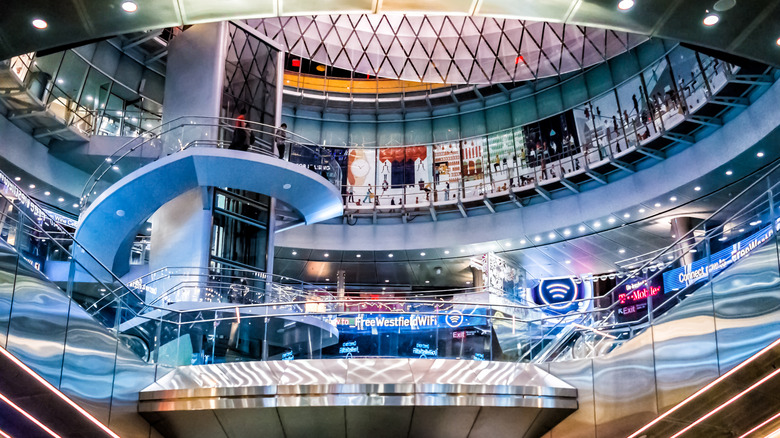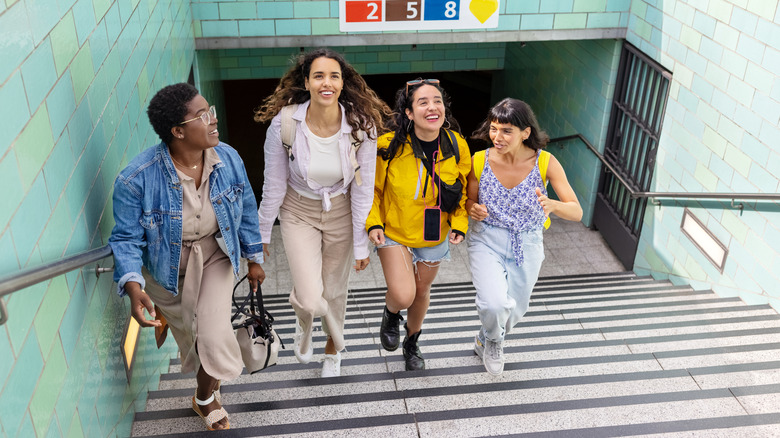The World's Most Jaw-Dropping Subway Stations, According To Experts
We may receive a commission on purchases made from links.
Subway stations serve the main purpose of getting commuters from point A to point B and back home again, but people don't expect world-class designs in their rush-hour squeeze. And tourists certainly don't expect them to compete with the sites they're on their way to visit. We've browsed expert publications, articles, and lists and thrown in a little personal experience to come up with what we think are some of the most striking underground transit stops on the planet. They're visually and architecturally stunning — a far cry from the usual drab, utilitarian stops we barely even notice — and some are even destinations in themselves.
With their artistic designs, bold lighting, historical references, and cultural symbolism, even if you're not a transit lover, these stations redefine what public infrastructure can be. Our list spans the entire globe, from Europe's underground cathedrals to Asia's artistic dreamscapes and some of America's underrated gems.
Old City Hall Station, New York, USA
The New York City subway system opened in 1904, and Old City Hall Station (not to be confused with City Hall Station) served as its first departure point. However, by 1923, the stop was barely used, and it was permanently closed in 1945. Designed by architects George Heins and Christopher Lafarge, with signature tilework by Rafael Guastavino, Old City Hall is more cathedral than commuter hub. With brass chandeliers casting light across colored glass tiles, skylights dappling the space with softened daylight, and its most prominent feature, high-arched ceilings, Old City Hall simply exemplifies architectural grandeur.
To see this abandoned NYC subway stop, a $65 New York Transit Museum membership and an additional $50 tour ticket are required — and you need to snap up those tickets fast, especially in spring when they can sell out in minutes. However, for a free glimpse, you can catch the downtown number 6 train and stay on during its turnaround of the station. Choose the seventh, eighth, or ninth car for the best views.
Arts et Métiers Métro Station, Paris, France
To mark the 1994 bicentenary of the prestigious Musée des Arts et Métiers (Museum of Arts and Crafts) in Paris, renowned Belgian comic artist François Schuiten collaborated with acclaimed French cartoonist Benoît Peeters to completely transform the Arts et Métiers Metro Station. They drew on the creative vision of legendary writer Jules Verne and his novel "Twenty Thousand Leagues Under the Sea" to reimagine the train station as a visual homage to humanity's most fascinating industrial dreams. The project basically turned a standard stop into a celebration of invention, storytelling, and classic science fiction.
The gleaming copper walls and circular peephole-style windows found on Line 11 create an unmistakable steampunk environment. The copper panels sweep across the walls, scrubbing the station clean of commercial ads, while burnished golden portholes illuminate scientific and cultural stories. Then there are the intricate models from the museum's collection, such as oversized ceiling cogs and a decorative cogwheel embedded in the wall, providing glimpses into past technological triumphs and syncing perfectly with the museum's industrial legacy.
Toledo Metro Station, Naples, Italy
Toledo Station is considered one of the most beautiful transit stations in Europe and the standout entry in Naples' ambitious Art Stations project, a citywide effort to turn everyday infrastructure into public art. The entrance is marked by three hexagonal pyramids and a corten steel statue known as the Knight of Toledo. Passengers then enter a stark, black-walled atrium that merges with archaeological remnants discovered during digging.
Near the platform, a dramatic 80-foot LED installation simulates the rolling motion of waves, while the centerpiece of this subway stop is a colorful, light-filled shaft that was originally used to remove excavated rock. It's known as the Crater de Luz, and it cuts through the entire metro station and pours daylight into its depths. Designer Òscar Tusquets Blanca stated, "The plan was to fill in this cavern, but I suggested not closing it completely. Preserving a crater seemed like an attractive idea. It would be magical if travelers could see the depth at which they were and glimpse the sunlight up there."
Formosa Boulevard MRT Station, Kaohsiung, Taiwan
The Formosa Boulevard MRT Station in Taiwan's second-largest city, Kaohsiung, is no ordinary station. It's a contemplative landmark that captures the beauty of collective imagination. The entrance was designed by celebrated Japanese architect Shin Takamatsu, whose conceptual intent was to symbolize hands pressed together in prayer. The result is a near-perfect triangular symmetry design that reinforces a peaceful, harmonious spirit.
But the underground stop's magnificent centerpiece is the Dome of Light, a breathtaking work of art by Italian artist Narcissus Quagliata. It's created with more than 4,500 hand-crafted glass panels and spans almost 100 feet in diameter across 7,100 square feet. The project took four years of painstaking effort to complete and stands as one of the largest glass installations in the world.
It's divided into sections of vivid color and abstract imagery that represent various stages of human life. Water symbolizes birth, earth represents growth, light reflects creativity, and fire embodies destruction followed by renewal. It's such a spectacle that many people come just to witness the dome's overwhelming, cathedral-like scale and periodic light shows of choreographed waves of color without any intention of catching a train.
Metro Center Station, Washington, D.C., USA
Sitting beneath the heart of downtown Washington, D.C., Metro Center Station is one of the city's most chaotic transfer hubs. It links the busy Red, Orange, and Blue Lines, but before going down to the bustling platform, passengers can ponder and prepare by treating themselves to a few minutes of art by Washington-based muralist G. Byron Peck. He is known for his large-scale public artworks, and his "Scenes of Washington" mural dominates the station's mezzanine. It's 60 feet of hard-hitting color, fractured geometry, and layers of local landmarks all colliding into a kind of controlled chaos. You'll spot Jefferson beside cherry blossoms, guardian lions beside gridlines, and broken columns next to stone reliefs.
Downstairs, the platform hits like a concrete cathedral. It's 600 feet long and arched 30 feet high. The vaults are patterned with rows of recessed rectangles, each softened at the corners and casting shadows between them. Architect Harry Weese designed the space to feel precise, stripped back, and massive, and the result is both imposing and strangely calming.
T-Centralen tunnelbana station, Stockholm, Sweden
T-Centralen is the beating heart of Stockholm's tunnelbana system and the first station in Sweden to incorporate public art. Now known as the "World's Longest Art Gallery," the Stockholm metro features artwork in the majority of its stations, with contributions from over 200 artists. But it's the blue line platform at T-Centralen that stands out most. It was designed by Swedish artist Per Olof Ultvedt, who painted elaborate silhouettes of leaves and vines in cool blues to soften the transport hub's hectic nature. They stand out vividly against the white, cave-like walls and ceilings and give the stop a serene, underground cavern feel.
Art guide Marie Andersson explained, "Ultvedt wanted to create a calming atmosphere because this is a station where people are in a hurry... the simple motifs give passengers pause and a chance to clear their minds." However, the northern entrance became worn out over time, which prompted a redesign by Wester + Elsner, who said, "If we build a really nice environment, people will appreciate it and look after it." The refurbishment featured cherry wood paneling on the walls, sound absorption, color-enhancing light, and "more open views [to] create a safer environment without hidden surprises."
Olaias Metro Station, Lisbon, Portugal
The modest ceramic tile-clad exterior of Olaias Station's ground-level entrance in Lisbon, Portugal, belies the color-filled chaos hidden beneath. With bright hues of glowing glass panels throughout, the station has been compared to "a giant kaleidoscope" by Daniel Wright, author of The Beauty of Transport. Massive, rust-red, steampunk-style pillars with exaggerated rivets support the colorful ceiling and hold the weight of the city above, while the platform hall has rainbow-hued walls of polygonal shapes and a smooth, reflective floor that mirrors the spectrum of colors above.
Wright goes on to colorfully explain that "the whole experience borders on the unreal. You're Alice in a transport wonderland, the ultimate polychromatic riposte to the muted colours and raw concrete finishes of most modern metro stations." It's a stop that favors rich visuals and symbolism and one that you would pay the ticket price for even if you weren't going anywhere near its Red Line destinations.
Universidad de Chile Metro Station, Santiago, Chile
One of the busiest metro stations in Santiago is Universidad de Chile. It connects two major lines in the heart of the capital, and the entrance is clean and practical, much like any metro stop in the world. But the moment you step down onto the platform, you're surrounded by Chilean history painted wall to wall. There are no distracting ads or obstructing signs. The space is open, with clean sightlines and uninterrupted surfaces, giving the mural full visual dominance.
On one side of the platform, the Memoria Visual de una Nación (Visual Memory of a Nation) pulls you back through the country's era of brutal colonization, with scenes of Indigenous life giving way to conquest and repression. On the other side, history moves forward into protest, dictatorship, and the chaotic, disjointed nature of the modern era. There's no filler — every face and every gesture feels deliberate. The lighting is stark, but that's intentional. Nothing is cast into shadow, keeping your admiring eyes exactly where artist Mario Toral envisioned them to be.
Westfriedhof U-Bahn Station, Munich, Germany
Munich may be one of the most walkable cities in the world, but the delights of Westfriedhof station may well tempt you to use the U-Bahn, or at least convince you to buy a ticket to take a look. The standout feature is 11 giant dome lamps that measure almost 12 feet in diameter and glow in primary neon colors. This light and color transform the plain concrete into something enchanting and atmospheric and make it feel less like an underground station and more like somewhere you'd actually want to spend time.
The gray concrete walls were left bare and rough on purpose. Colors reflect off them to create layered shades and a surreal glow, offering a bit of calm to hurried passengers. It's simple, bold, and way more effective than it should be. The architecture studio Auer and Weber is the designer, while the lighting concept was developed by the late Ingo Maurer, who believed that "the quality of light is more important than the form" (as reported by the Vitra Design Museum), and his philosophy lives on in this creation of mood-enhancing illumination.
Sanam Chai MRT Station, Bangkok, Thailand
Bangkok is a vibrant hub of street life, temples, and world-class eats, and Sanam Chai Station sits in one of the city's most historic and tourist-friendly locations. It's just a five-minute walk from the incredible Wat Pho with its surreal reclining Buddha, and also relatively near the iconic Grand Palace and its connecting site, Wat Phra Kaew (Temple of the Emerald Buddha). The station was designed by Dr. Pinyo Suwankiri and gives tourists easy access to an area where they will likely want to spend the entire day.
The walls are lined with white columns topped in gold, the ceiling is decorated with carved floral patterns and gridded wood panels, and chandeliers hang down in uniform rows. In fact, Sanam Chai is more like the temples that tourists flock to see in the area rather than a simple subway station. Everything is polished, bright, and symmetrical, and the deep red paint was even custom-made. It perfectly sets visitors up for the epic sites they have come to witness.
Università Metro Station, Naples, Italy
Another stop in the Naples' Art Stations project well worth a mention is Università. It was designed by Egyptian-born industrial designer Karim Rashid, who created spaces that, according to Italian architecture magazine Domus, speak "directly to the emotions of passers-by through spaces that reflect knowledge and languages of the new digital age." Inside the atrium are two sculpted black columns that form giant opposing faces, apparently in conversation with each other, reinforcing the station's theme of connection. It's intriguing, and it's just the start.
The escalator tunnel is lined with glossy turquoise walls, a reflective silver ceiling, and glowing orange handrails. The walls then shift to a saturated yellow, and the floor tiles feature patterned bands of pink, orange, and purple in curved, ripple-like designs. Nothing appears muted — everything is high-gloss and intensely colored. Down on the platforms, the walls are lined with glowing artworks that seem to animate the longer you stare at them. All in all, Università Station is a sensory overload that creates an unforgettable underground experience.
Glen Park BART Station, San Francisco, USA
Bay Area Rapid Transit (BART) stations are often described as drab, gray, and purely functional. However, Glen Park BART Station in San Francisco proves otherwise. The entrance may be classic Brutalism with raw, unfinished concrete and heavy blocks trying their best not to look pretty in any way, but inside, it's a different chapter altogether. Noted architecture critic John King mentioned in his book "Cityscapes: San Francisco and Its Buildings" that "the boxy exterior with its drab plaza gives no hint of what's below."
Designed by Ernest Born and Corlett & Spackman in 1973, the interior concrete is carefully shaped and paired with skylights, marble, and geometric features with clear thought. The concourse is flooded with natural light, cutting across the concrete and Carrera marble to create heavy shadows and open space. Down below, the platform feels carved out of stone, and its rough cladding and board-formed concrete walls give the impression it was chiseled directly from the earth. Even the escalators take advantage of the contrasting design, elevating arrivals from the darkness into the light and contributing to the station's quiet drama.
Kosmonavtlar Metro Station, Tashkent, Uzbekistan
The former Soviet state of Uzbekistan may not be the most popular choice of destination for a vacation, but with a metro system that makes the pages of National Geographic, it makes you wonder what other delights the country hides. The capital city, Tashkent, is home to Kosmonavtlar station, and it's so beautiful that it was actually illegal to take photos inside until 2018. Okay, that last point was made up; photography was actually banned due to its secondary role as a nuclear bomb shelter — not quite as romantic, but interesting nonetheless.
With walls tinted in deep blue to mimic outer space and ceramic bas-reliefs of Soviet cosmonauts (Yuri Gagarin and Valentina Tereshkova included), the station celebrates the Soviet space program. The portraits feel dreamlike, with smooth lines and expressions that lean more toward myth than military, taking a left turn from the rigid, cold art for which the era is known. The space theme is layered over a visual style that includes Islamic-inspired geometric patterns reflecting Uzbek cultural heritage. It is this propaganda art rendered through an Islamic-inspired lens that gives Kosmonavtlar Metro Station its originality.
Noksapyeong Station, Seoul, South Korea
If you're ever in the Yongsan District in Seoul, South Korea, make sure you visit the Noksapyeong Station. This entire transit hub has been described as "one big art project" and drops dramatically down through five levels underground. It feels much deeper than it actually is, thanks to a central escalator that stretches all the way from ground level to the platform. This deep underground design wasn't just conceived for aesthetics, however. It was supposed to support a future transfer line that never materialized.
A 21-meter-wide glass dome tops the atrium and floods the space with sunlight. Hanging beneath is a suspended white mesh dome known as the Dance of Light. It's an overhead art piece that plays with natural light, shifting and changing it subtly as the day progresses. Leading architecture website ArchDaily reported that designers Naruse Inokuma Architects hoped "that by spending some time ... you will come to sense a certain dynamism of nature." It's anything but ordinary. However, Noksapyeong Station features other artsy displays, including the "Underground Art Garden," which showcases several art pieces, such as "Forest Gallery" by Kim Ah-Yeon, and an exhibition on Yongsan's history and culture, including its connection to the former U.S. Army base Yongsan Garrison.
Fulton Street Station, New York, USA
Before you descend down into the chaotic NYC subway system at Fulton Street Station, you may want to go through Fulton Center, a transit hub and retail complex in Lower Manhattan. It might be more high-end mall than a hallowed civic space, but it is quite impressive from a contemporary point of view. Its centerpiece is the Sky Reflector-Net, a large sculptural installation suspended inside a central atrium made of 952 unique aluminum panels that reflect natural light down into the main concourse.
When you descend down into Fulton Street Station, things get older and a little more maritime. That's because this subway stop leans hard into New York's nautical past. Murals along the corridors show depictions of ocean liners and steamships. Among them is a 1905 bas-relief of the Clermont — the first commercially successful steamboat in the U.S., which was designed by Robert Fulton, after whom the street is named. Then, mounted low on the corridor walls are salvaged terracotta panels that show sailing ships, tugboats, and steamers that stretch back through 300 years of New York Harbor history.
Methodology
To compile this list, we drew from a range of sources, primarily design and architecture websites, including ArchDaily, Parametric Architecture, ELLE Decor, and My Modern Met. Additional input came from major news outlets like The Guardian in the U.K. and CNN in the U.S., as well as travel sites such as Lonely Planet. We looked to garner the opinions of expert designers, architects, and critics, but we also leaned ever so slightly on personal experience acquired from a couple of the stations.
